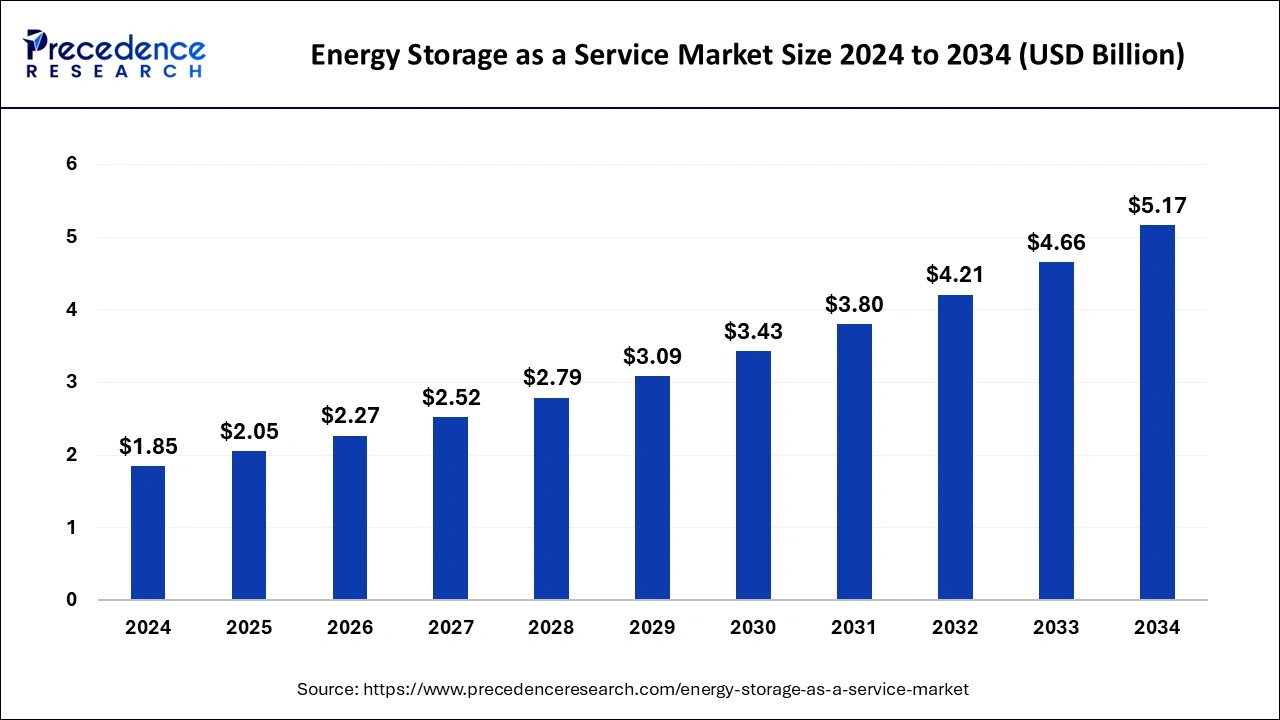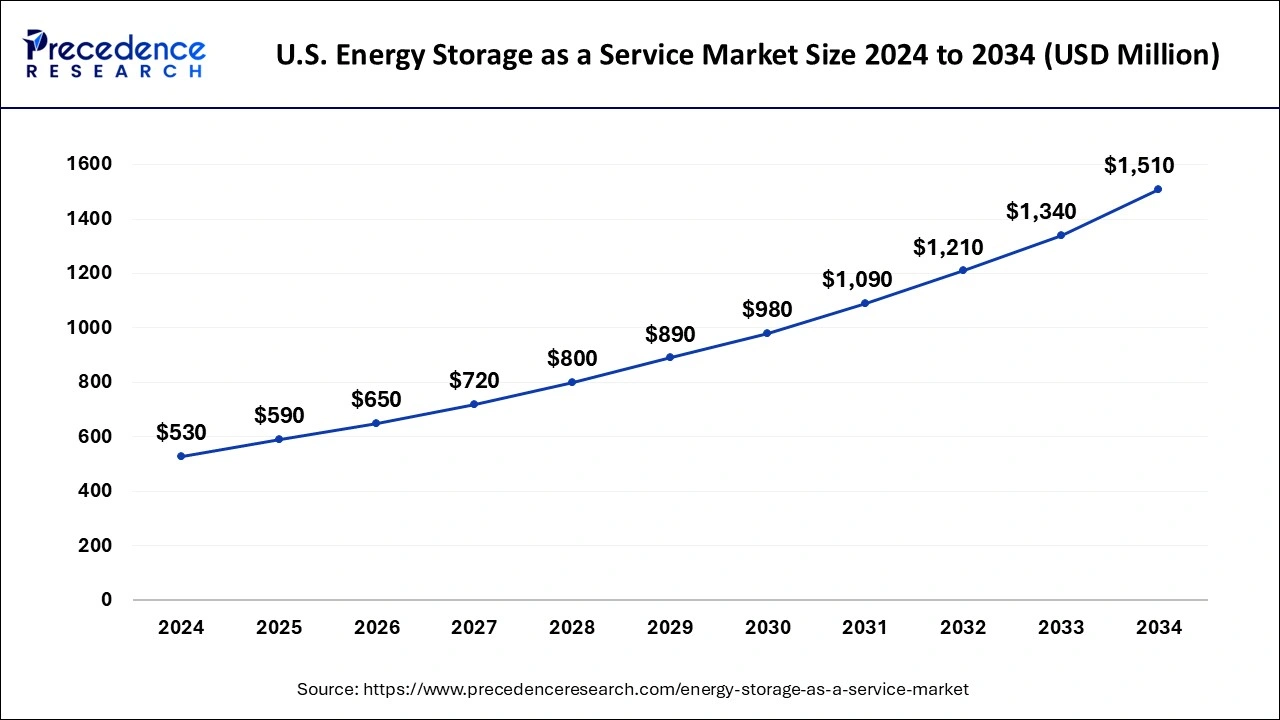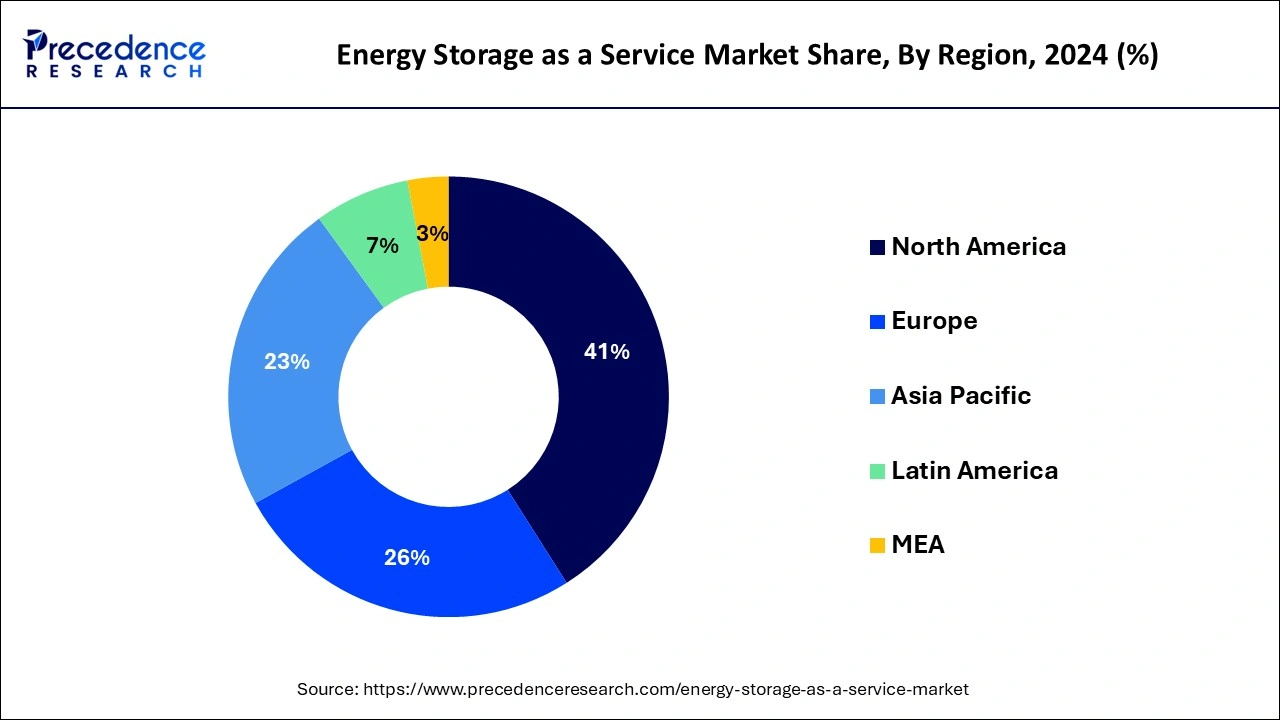List of Contents
Energy Storage as a Service Market Size and Forecast 2025 to 2034
The global energy storage as a service market size accounted for USD 1.85 billion in 2024 and is predicted to reach around USD 5.17 billion by 2034, expanding at a CAGR of 10.82% from 2025 to 2034. The essential features, such as backup power, grid stabilization, renewable energy integration, and reduced carbon footprint, drive the growth of the energy storage as a service market.

Energy Storage as a Service Market Key Takeaways
- North America dominated the global market with the largest market share of 41% in 2024.
- Asia Pacific is projected to expand at the notable CAGR during the forecast period.
- By services, the customer energy management services segment has held the largest market share in 2024.
- By services, the ancillary services segments is estimated to be the fastest-growing segment during the forecast period.
- By end user , the industrial, residential, and commercial segment captured the biggest market share in 2024.
- By end user , the utility segment is expected to grow at a significant CAGR from 2025 to 2034.
Role of Artificial Intelligence in the Energy Storage as a Service Market
Integrating AI into energy storage offers smart energy use, cost, and resource savings. AI algorithms optimize energy management and improve battery storage systems. AI offers maintenance and cleaning, as well as monitoring inverter conditions and panel output. AI can monitor weather forecasts and calculate energy storage. AI makes possible energy production and energy consumption prediction by using weather and satellite data, statistical analysis, and numerical weather prediction models. With the help of AI, energy storage operators can immediately act for predictive maintenance. AI can detect anomalies and errors across electrical, thermodynamic, and chemical subsystems and inform operators before any failures.
U.S.Energy Storage as a Service Market Market Size and Growth 2025 to 2034
The U.S. energy storage as a service market size was exhibited at USD 530 million in 2024 and is projected to be worth around USD 1,510 million by 2034, growing at a CAGR of 11.04% from 2025 to 2034.

North America dominated the market with a revenue share of 41% in 2024. This is due to the growing need for smart buildings and building automation. The energy storage as a service market is developing due to rising demand for services such as offering demand energy response solutions and implementing energy efficiency projects as a result of the growing commercial industry.
The high energy consumption is due to the presence of several industries across the automotive, chemical, healthcare, and aerospace sectors. The growing demand for services such as peak load, black start, energy arbitrage, and demand charge management in residential, commercial, and industrial sectors contributes to the market's growth in the North American region. The industrialists prefer to purchase energy storage systems for energy storage services for regular energy supply and to avoid blackouts.

Asia-Pacific is expected to develop at the fastest rate x% during the forecast period. This is attributed to the presence of a number of undiscovered markets as well as increased energy consumption in Asia-Pacific. Moreover, the region's rapid industry, high energy use, and greater knowledge of renewable energy sources.
The increasing industrialization and rising energy consumption drive the market's growth in the Asia Pacific region. The countries in India, South Korea, Japan, and China have strong presences of industries that focus on business models, which is expected to accelerate the adoption of energy storage systems. The increased utilization of these energy storage services in their system would boost their demand shortly. Deploying resilient and distributed microgrids with energy storage and renewables would also drive the market's growth in this region.
Market Overview
Energy storage as a service is an essential part of the modern grid through which several economic models became accessible. The generated energy is used to offset the needed carbon-emitting manufacturing. It provides the load shifting capabilities and this contracted service is managed by a third party automatically. The facilities can allocate resources to control the energy profile and focus on primary activity. It ensures the reduction of expensive hours of electric consumption and cutting electricity bills at no cost to the building owners. The growing shift towards renewable energy generation and significant investments accelerates the growth of the energy storage as a service market. It became a critical part of power management systems due to the rising demand for energy storage devices based on time, days, and seasons. The economic markets of the world are trying to improve power generation and the utilization of renewable energy sources.
Energy Storage as a Service Market Growth Factors
- Energy storage as a service is gaining popularity among service providers in particular.
- Energy and sustainability managers in corporate commercial and industrial organizations are increasingly looking for cost-effective, tailored, and comprehensive energy solutions that ensure energy consumption reduction and cost savings without affecting day-to-day operations.
- Energy storage as a service is a fee-for-service or management approach for deploying advanced energy storage and energy management systems rather than direct purchase of the asset by the end user.
- The concept of energy storage as a service is being used in other places to deliver consistent returns for investors after a distributed energy storage system project is completed.
- Energy storage as a service is a promising concept that has the ability to attract financing and further grow the industry, as energy storage transactions were previously avoided by investors due to the complexity of cash flow.
- Energy storage as a service generally benefits large energy consumers with average consumption of above 500 kW, although depending on regional incentives, the energy storage as a service may also benefit smaller facilities.
- Electrical, chemical, metal, lighting, petrochemical, and plastics manufacturers, resources such as oil, pulp and paper, metals and ore extraction, and food processing are all early adopters of energy storage as a service.
- The growing investments in energy distribution infrastructure will surge the demand for distributed energy resources, propelling the energy storage as a service market.
- As a result, demand for energy storage as a service is projected to be driven by the growing requirement for distribution systems and major investment to improve grid efficiency.
Market Scope
| Report Coverage | Details |
| Market Size in 2025 | USD 2.05 Billion |
| Market Size in 2034 | USD 5.17 Billion |
| Growth Rate from 2025 to 2034 | CAGR of 10.82% |
| Base Year | 2024 |
| Forecast Period | 2025 to 2034 |
| Segments Covered | Services, End User, Component, Geography |
| Regions Covered | North America, Europe, Asia-Pacific, Latin America, and Middle East & Africa |
Market Dynamics
Driver
The different types of energy storage systems for electricity such as pumped hydro storage, battery energy storage systems, compressed air energy storage, flywheels, thermal energy storage, etc. drive the growth of the market remarkably. The expansion of renewable energy and net-zero goals contribute to the rising demand for efficient energy storage systems. The countries like Spain, the United States, and the United Kingdom are developing plans to encourage long-duration energy storage (LDES).
Restraint
High energy costs and short energy storage durations can be issues in the adoption of some energy storage systems. Energy storage systems with short durations supply energy for a few minutes.
Opportunity
The innovations in energy technologies can enable low-cost electric energy storage systems to supply power for 10 hours or more. These efforts could stabilize power supplies with the arrival of renewable energy sources in online forms.
Services Insights
In 2024, the customer energy management services segment accounted revenue share of 31%. In comparison to utility and energy supply firms, the energy storage as a service model is gaining favor in the industrial, commercial, and residential sectors. The microgrid systems make use of it.
The ancillary services segment is predicted to develop at the quickest rate 11.8% in the future years. Ancillary services including as black start, voltage support, and frequency management are projected to reduce reliance on fossil fuel generators and shift to renewable and battery energy storage.
End User Insights
The industrial, residential, and commercial segment dominated the market in 2022 with revenue share of 71%. Commercial buildings with higher energy usage have energy applications such as district energy systems and service.
The utility segment is expected to witness growth at a CAGR of 11.3% during the forecast period. The segment's growth is being fueled by a decrease in reliance on traditional fossil fuel generators and a greater focus on sustainability.
Key Developments
- Sonnen, a major operator in the sectors of smart energy storage systems and novel energy services for households was acquired by Royal Dutch Shell PLC in February 2019, increasing its offerings of residential smart energy storage and energy services.
- Renewable Energy Systems was given a four-year contract in the UK in September 2016 to offer frequency response services to the National Grid network using a 35-MW lithium-ion battery energy storage system.
- Engie Group and Google signed a deal in August 2021 to provide carbon free electricity in Germany. The arrangement will help Google meet its carbon free energy goals for its data centers, cloud regions, and offices throughout the world by 2030.
- Schneider Electric, a French multinational corporation that specializes in energy and digital automation solutions, announced a partnership with Huck Capital, an investment firm, in August 2020 to provide clean energy as a service to commercial and industrial buildings.
The mergers and acquisitions, partnerships, new product development, business expansions, collaborations, supply contracts, agreements, and contracts are some of the important marketing strategies used by the major market players to maintain their market position.
Energy Storage as a Service Market Companies
- Siemens Energy
- Honeywell International Inc.
- ENGIE Storage Services NA LLC
- Veolia
- NRStor Inc.
- YSG Solar
- Suntuity
- Hydrostor Inc.
- Customized Energy Solutions Inc.
- Johnson Controls
Recent Developments
- In September 2024, Honeywell Automation India Limited announced the delivery and commissioning of a microgrid battery energy and storage system in India for the Solar Energy Corporation of India's (SECI) Lakshadweep Islands Project. Honeywell continues to supply state-of-the-art energy management systems, microgrid controllers, power plant controllers, and more to manage the distribution of renewable energy through a range of BESS sub-systems.
- In November 2024, Veolia announced the establishment of a new waste-to-energy plant through a strategic partnership for the next 25 years for a public service delegation to supply electricity to about 3,000 households and district heating and local energy produced from the waste to nearly 6,500 households. The waste-to-energy plant intended for the region is set to have a treatment capacity of 79,200 tonnes of non-recyclable household waste per year, saving 40,000 tonnes of carbon emissions annually with the production of 41,000 MWh of electricity, enough to offset to carbon footprint of 18,700 inhabitants.
Segments Covered in the Report
By Services
- Bulk energy services
- Ancillary services
- Transmission infrastructure services
- Distribution infrastructure services
- Customer energy management services
- Others
By End User
- Utility
- Industrial, residential and commercial
By Component
- Energy Storage System
- Control and Monitoring System
- Service Contract
By Geography
- North America
- U.S.
- Canada
- Europe
- U.K.
- Germany
- France
- Asia-Pacific
- China
- India
- Japan
- South Korea
- Malaysia
- Philippines
- Latin America
- Brazil
- Rest of Latin America
- Middle East & Africa (MEA)
- GCC
- North Africa
- South Africa
- Rest of the Middle East & Africa
For inquiries regarding discounts, bulk purchases, or customization requests, please contact us at sales@precedenceresearch.com
Frequently Asked Questions
Ask For Sample
No cookie-cutter, only authentic analysis – take the 1st step to become a Precedence Research client